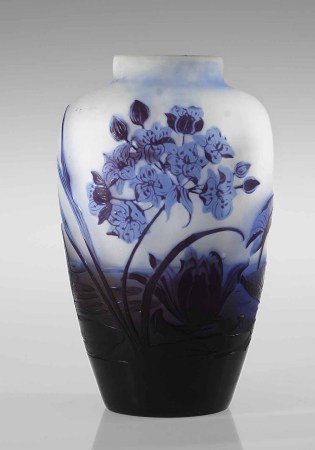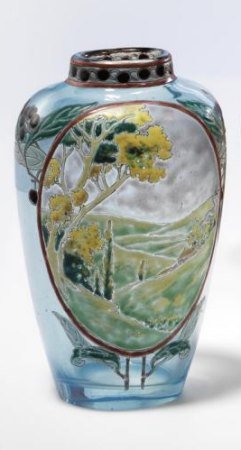GALLE CAMEO GLASS
Emile Gall� (1846 - 1904) was and is the dominant figure in French cameo glass and was perhaps the most outstanding person working in glass in the Art Nouveau period. He was student and teacher, worker and director, craftsman and artist. He demonstrated fine skills as botanist, chemist, author, and businessman in addition to those shown in his work with ceramics, furniture, and glass.
His father, who owned a local glass and faience factory, inspired Galle to enter the glass industry. This sparked his interest in glass as a medium for artistic expression.
He began working for the Burgun, Schverer glass company in Meisenthal before establishing his own company in 1873. While he found experimenting with classical and enameled designs interesting, his aspirations were dramatically expanded when seeing the International Exhibition in Paris in 1878. There, he was exposed in particular to the cameo glass of Joseph Locke and John Northwood from England and Eugene Rousseau in pate de verre. Galle was about to combine his love of nature, his chemical training, and his artistic eye to the worlds of cameo glass, caramics, marquetry, and beyond.
Galle opened a small woodworkers shop in 1885 where he began experimenting in marquetry designs in furniture, and he continued working at his father's factory. In 1889, Emile Galle displayed his new glass creations at the Paris International Exhibition, designs and colors not previously seen and causing an immediate sensation. |  |
 |
At the 1900 International Exhibition in Paris, Gall� had an outstanding exhibit with many fine pieces of glass and with a working glass furnace in the centre of the display He was highly acclaimed, and this experience was probably the high point of his career. Galle was honoured as the head of the Ecole de Nancy (School of Nancy). Membership in this 'school' consisted of a number of men who had achieved prominence in their particular fields, including: Hesteaux, a potter; the Daum brothers, manufacturers of fine glass; Victor Prouve, a painter and artist in other media; Majorelle, the outstanding furniture maker and others.
Galle continued to produce some glass of masterpiece quality into the final year of his life.
Galle died in 1904 and his widow continued to make Galle glass designs in the factory until the advent of World War I in 1914 and still using his signature on the pieces but adding a star after the 'Galle' following his death. After World War I, Paul Perdrizet, Emile's son-in-law, began producing Galle glass once again, even adding new designs and primarily making the multi-layer cameo glass in floral and landscape designs. Galle cameo glass was both wheel cut and acid etched, both techniques which required fine craftsmanship to produce and in which layers of multi-colored glass is progressively removed to create the designs.
All Galle production ceased in 1936 although reproductions and fakes are still made in great quantities to fool the uninformed. |
|
没有评论:
发表评论